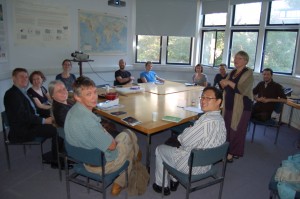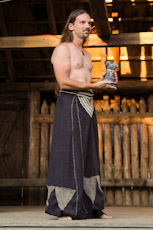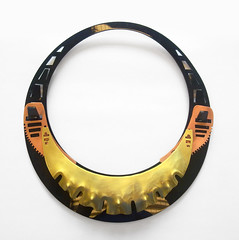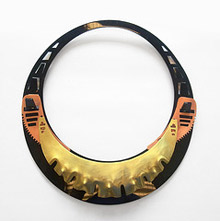-
Latest news
Live Project Exhibition
Project members' blogs
Live Project Exhibition
In the academic year 2010-2011 the CinBA Project invited course leaders of contemporary craft subjects at Higher Education and Further Education level to become involved in the research through a Live Project opportunity for their students. Using Bronze Age objects as sources for their own research-based practice, participating students were asked to design and develop new contemporary craft objects in response to the prehistoric material. They were not limited to the media that are the archaeological focus of the project (ceramics, textiles and bronze) but were also invited to develop ideas in other materials, focussing on motifs, design elements, complete objects, or any combination of these.
Posted in News
Leave a comment
Young Animators
The children took part in the CinBA project through a collaboration between Southampton University and the weekly animation club run by teacher and digital media facilitator Peter Harvey in Bitterne Park Secondary School. Find out more >>
Posted in News
Leave a comment
Plenary lecture on pottery
 Dr Joanna Sofaer joined the CECT Conference ‘Things in Culture, Culture in Things’ in Tartu by video link on 21 October to give a plenary lecture on Bronze Age bowls, a common vessel type in the European Bronze Age which has been found in both settlement and cemetery contexts. The lecture explored how bowls may have been used to tell stories (more specifically cosmological myths) from the Early Bronze Age to the Late Bronze Age / Early Iron Age in the Pannonian region (modern-day Hungary and northern Croatia).
Dr Joanna Sofaer joined the CECT Conference ‘Things in Culture, Culture in Things’ in Tartu by video link on 21 October to give a plenary lecture on Bronze Age bowls, a common vessel type in the European Bronze Age which has been found in both settlement and cemetery contexts. The lecture explored how bowls may have been used to tell stories (more specifically cosmological myths) from the Early Bronze Age to the Late Bronze Age / Early Iron Age in the Pannonian region (modern-day Hungary and northern Croatia).
Over this period, changes in the relationship between the shape and decoration of bowls show a shift in emphasis from two-dimensional to three-dimensional use of the vessel surface. This can be understood in terms of the development of design principles that allowed the presentation of common Bronze Age motifs, such as the sun and the wheel, through vessel form as well as surface decoration. Pots were thus used as mnemonics for wider cosmological notions. Middle and Late Bronze Age developments in vessel form also created possibilities for the display of stories in new and overt ways through hanging vessels on walls. Moreover, changes in the location of motifs on bowls provided opportunities for the concealing or revelation of stories depicted by them. Finally, if pots were used to tell stories, then this places potters in the role of storytellers.
Watch the video below or visit the conference video site for more videos from Tartu.
Posted in News
Leave a comment
Metals workshop in Cambridge
 The Metals group met in Cambridge on 30 September 2011 to plan its forthcoming volume Thinking Through Bronze. This volume aims to address bronze as a medium for reflection and interaction by focusing on the properties and qualities that are particular to bronze. The authors will also explore how far we can identify why people in the Bronze Age would have perceived bronze as different from other materials.
The Metals group met in Cambridge on 30 September 2011 to plan its forthcoming volume Thinking Through Bronze. This volume aims to address bronze as a medium for reflection and interaction by focusing on the properties and qualities that are particular to bronze. The authors will also explore how far we can identify why people in the Bronze Age would have perceived bronze as different from other materials.
During the workshop, team members discussed the effect of the reversibility of bronze on the perception of the material, how ideational concepts such as ‘birdness’ were articulated through bronze, how bronze influenced social interaction and how the productive engagement with bronze has affected ideas about craftsmanship.
Posted in News
Leave a comment
Sheep and Man seminar on 28th October 2011
Sheep and Man is an interdisciplinary research seminar about the relationship between humans and sheep in prehistory. A DNA specialist, textile and fibre experts, a zooarchaeologist and an archaeologist are presenting their research at Suhmhuset.
Speakers include Dr Elena Nikulina of the Zentrum für Baltische und Skandinavische Archäologie; Dr Margarita Gleba, University College London; Dr Antoinette Rast-Eicher, ArcheoTex, Switzerland; Jacob Kveiborg, Aarhus University; Dr Anne Karin Hufthammer, University of Bergen; and Dr Kristin Armstrong Oma, University of Oslo.
Sheep and Man is organized by the Department of Archaeology and Religious Studies in connection with the HERA JPR project Creativity in Craft Production in Middle and Late Bronze Age Europe (CinBA).
Location: Suhmhuset, Vitenskapsmuseet, Trondheim, Norway
Have a look on seminar programme
Everyone is welcome!
Posted in News
Leave a comment
Celtic Festival at the Mitterkirchen Celtic Village
 Mitterkirchen is a former Celtic village set on the Danube. After significant finds between 1980 and 1990 an original Celtic village was built, showing how the Celts lived 2,700 years ago. Organized in cooperation with the Upper Austrian Regional Museum and Vienna University, a Celtic Festival takes place every two years, covering a wide spectrum of events (danube.at).
Mitterkirchen is a former Celtic village set on the Danube. After significant finds between 1980 and 1990 an original Celtic village was built, showing how the Celts lived 2,700 years ago. Organized in cooperation with the Upper Austrian Regional Museum and Vienna University, a Celtic Festival takes place every two years, covering a wide spectrum of events (danube.at).
CinBA project members were part of the organizing team focusing on clothing and textile craft. Follow the link to view the exiting fashion show.
Posted in News
Leave a comment
Public lecture about Hallstatt prehistoric salt mine and its textiles
 Lecturer: Dr Karina Grömer, Naturhistorisches Museum, Wien
Lecturer: Dr Karina Grömer, Naturhistorisches Museum, Wien
Time: Thursday, October 27th, 19:00, Auditoriet i Suhmhuset
Hallstatt in Austria is a UNESCO World Heritage site, one of the most famous archaeological sites in Europe. The earliest part of the Iron Age is called the Hallstatt period, due to rich archaeological finds excavated by Johann Georg Ramsauer 150 years ago. The reason is the abundant salt deposit in a valley high above the Hallstätter Lake. Salt has been extracted here for 7000 years.
Since 1960, archaeologists from the Naturhistorisches Museum Wien have been excavating in Hallstatt, and have discovered extensive mining systems from the Bronze Age as well as from the Iron Age. Deep shafts connected several galleries; remains of loading points, hoisting shafts, a collapsed wooden staircase and a variety of broken tools inform us of an advanced mining technology and knowhow. The salt has preserved an abundance of organic materials such as lighting tapers, rope, leather carrying sacks and palm protectors and remains of a variety of textiles – all things that very rarely survive the passage of time. They offer us tantalizing glimpses of the miners’ life, of prehistoric craftsmanship, and of the organisation and infrastructure that was necessary to keep the mines going.
The textiles recovered from the salt mines number more than 500 samples. This extraordinary collection makes it possible to track the development of European textile technology of the time, allow us to follow the development of fibres, the introduction of colours and various decorative designs, and how textiles were shaped into garments.
The Naturhistorisches Museum Wien is a partner in a HERA JPR-funded project, “Creativity in Craft Production in Middle and Late Bronze Age Europe (CinBA)”. Together with scholars from the NTNU, Department of Archaeology and Religious Studies, Dr Grömer and her colleagues form the Textile Team of the project.
Workshop for Designing the Interior of a Middle Bronze Age House in Asparn/Zaya, Austria
[singlepic id=577 w=320 h=240 float=right]The aim of the workshop was to make the interior and soft furnishing of a bronze age house together with the visitors of the musem. Usually houses in open air museum houses are very sparsely furnished, mainly with just few details such as fireplaces and other thinkgs what can be detected on archaeological excavations. The house chosen for the workshop was built 40 years ago. It has been empty since it was built, but now new interiour decoration will give you an impression, as if the prehistoric people living in this house just left from there few minutes ago.
There are many small items of daily life and work: pots, baskets with personal things, tools, places to sit and talk… This make the house more authentic. It is the recreation of the living environment of a wealthy Middle Bronze Age family.
The austrian textile group of the CinBA Project was ask to take care for the textiles and their production, which played a great role in the life of prehistoric people.
Posted in News
Leave a comment
Manchester School of Art Bronze Age Blog
 3D Design students at Manchester School of Art are participating in CinBA project by exploring the role that the craft maker can play inarchaeological enquiry, both as practice-based researchers-investigators and as interpreters of meanings within handmade objects from the Bronze Age period.
3D Design students at Manchester School of Art are participating in CinBA project by exploring the role that the craft maker can play inarchaeological enquiry, both as practice-based researchers-investigators and as interpreters of meanings within handmade objects from the Bronze Age period.
Posted in News
Leave a comment



 Follow us on
Follow us on 

